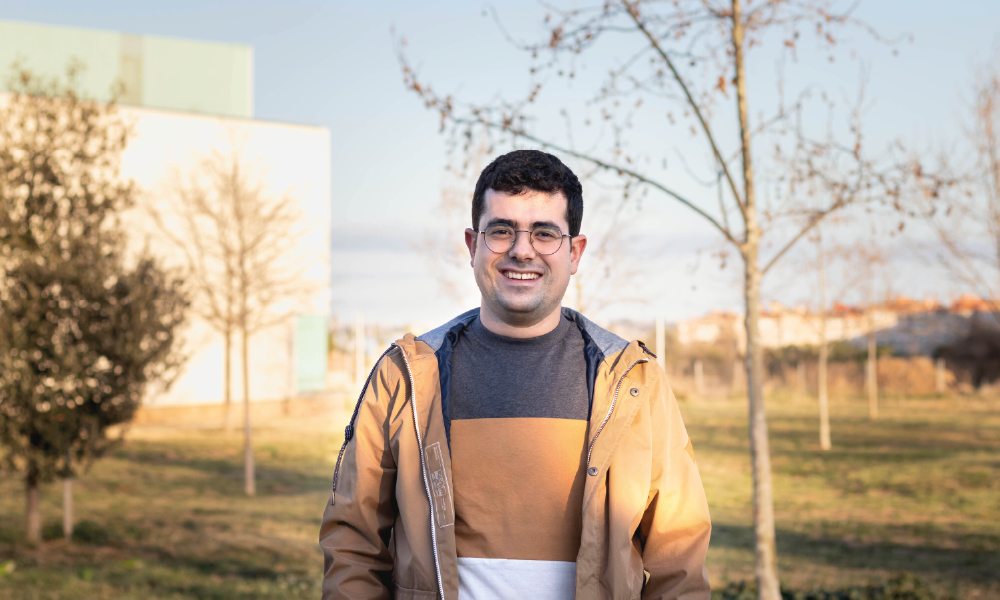
Welcome: Alejandro Torres-Sánchez
The new group leader is setting up the first purely theory-focused research group at EMBL Barcelona. He aims to understand fundamental biological principles using mathematical models and computer simulations, in close collaboration with experimental researchers across EMBL

From an early age, Alejandro Torres-Sánchez dreamed of becoming a professional trumpet player. He learned and played the instrument for more than ten years, but he had a second passion: physics. He now sets up his lab at EMBL Barcelona – the first research group in the unit that approaches tissue and disease modelling from a purely theoretical perspective.
Tell us a bit about your research.
In my group, we are mainly interested in the physical principles guiding biological processes. We want to investigate questions such as: how does the interaction between cell-fate decisions and mechanics lead to the different types of self-organisation and shapes that we observe in tissues? How does the crosstalk between different mechanical actors, such as the cell cortex and cell-cell adhesions, determine the emergent flow or deformation of a tissue? To answer these and similar questions, we employ mathematical models and computer simulations.
Your group is purely theory-based, focusing on computational models and simulations. How can mathematical models help in understanding the self-organisation and shaping of tissues?
Mathematical models are a great tool to identify fundamental principles. For instance, if we write the equations that regulate two different processes and they coincide, we know that they are equivalent, even though they might involve different ingredients or be happening at different scales.
Active matter theories are mathematical models that describe systems whose components are active ‘agents’. Examples of active matter are flocks of birds, herds of animals, or collections of cells. These theories are at the core of the models that we use in the lab, and can be employed to model subcellular mechanics, such as the behaviour of the cell cortex, and tissue scale processes, such as cell flows during embryo development. In many cases, these models differ only by a few ingredients, which allows us to understand the similarities and differences between them.
This is very useful when you want to identify fundamental principles behind self-organisation and shape generation in tissues. Because mathematical models are usually difficult to solve analytically – with pen and paper – we develop computational tools and high-performance computing methods to simulate our mathematical models on a supercomputer. This allows us to tackle realistic geometries with enough resolution.
How will EMBL take your research to the next level?
EMBL provides a unique research environment with a huge diversity of biological approaches. The new EMBL programme, with the inclusion of transversal themes that go from molecular building blocks to planetary biology, is an example of this diversity. I feel that within this environment, we will develop new interactions that I might not have been able to think about before and this is key to new and exciting scientific projects. The fact that EMBL as an organisation is devoting a full transversal theme to theory – Theory@EMBL – really shows EMBL’s commitment to the kind of research that we do. Last but not least, the whole EMBL infrastructure, with valuable resources and expertise, makes EMBL a great place to do scientific research.
Your group will collaborate with experimental researchers. What are other groups at EMBL Barcelona or other EMBL sites you would like to work together with?
This is one of the best aspects of having a theory-focused group at EMBL Barcelona. Here, there are many interesting groups doing experimental research, and we have the opportunity to collaborate with them. Currently, we are the only group at EMBL Barcelona that does not have a wet lab. We have already started collaborating with Vikas Trivedi’s group and have a project in mind with Maria Bernabeu’s group. We have just started, but of course, we would love to make connections with the other groups at EMBL Barcelona and with groups in other units, such as the Cell Biology and Biophysics, the Developmental Biology Unit in Heidelberg or at EMBL-EBI.
What is your philosophy for leading a team?
I want to incentivise cooperation, instead of competition, between my group members. In my experience, this helps not only in creating a good vibe in the group, but also in generating synergies between people with different backgrounds and specialties that lead to much better science. Following this essence, I would like to create an open atmosphere where we can really discuss scientific and non-scientific problems honestly. I think it is important to help people know what is expected from them and what they can expect from others in the group. This also helps to avoid misunderstandings. I would also like to have an open-door policy as much as possible, where people can just bump into my office whenever I am available. I like this dynamism, as I believe that these more informal conversations are sometimes more productive.
What is your favourite book or movie?
I love reading so this is a tough question to answer. I enjoyed 1984 a lot, but also the Foundation trilogy, or El árbol de la ciencia. In terms of movies, I have a special weakness for the original Star Wars trilogy, as I grew up watching them again and again.
If you were not a scientist, what would you be?
When I was a kid, I wanted to become a professional trumpet player. I started playing the trumpet when I was eight and continued playing for more than ten years. I loved it! Finally, though, I decided to pursue a degree in physics, which I loved as well, and here I am!


